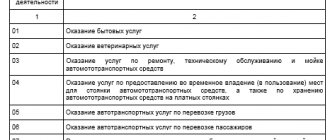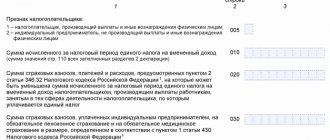The area of the trading floor under UTII: what is the limit for this special regime
There is no direct formulation of what a trading floor is in the Tax Code of the Russian Federation.
However, judging by sub. 2 p. 3 art. 346.2 of the Tax Code of the Russian Federation, then trading floors are part of stationary trade. They are separate and specially equipped premises in which retail trade and customer service are carried out. In other words, if part of the area in a retail space is allocated for customer service, it is considered that there is a sales area.
Paragraph 14th century 346.27 of the Tax Code of the Russian Federation refers to the objects of a stationary network in which there are trading floors, only shops and pavilions.
The store according to paragraph. 26 Art. 346.27 of the Tax Code of the Russian Federation is considered an equipped building or part of it if it:
- serves for the sale of goods and provision of services;
- equipped with premises intended for trade, storage of goods, their preparation for sale, accommodation of administrative personnel and auxiliary needs.
Pavilion according to paragraph. 27 Art. 346.27 of the Tax Code of the Russian Federation is considered a building that has a sales area and is designed for a small number of jobs (one or several).
When conducting retail trade in a store or pavilion, the taxpayer must keep in mind that the UTII regime will be available to him only until the area of the sales floor exceeds 150 square meters. m. This indicator according to subclause. 6 paragraph 2 art. 346.26 of the Tax Code of the Russian Federation is the limit for this type of activity and such premises.
For more information about the rules for calculating the area of a sales area, read the material “How to calculate the area of a sales area for the purposes of applying UTII?” .
The size of the sales area directly affects the amount of tax.
See this article for the formula for calculating it.
Quite often situations arise in which taxpayers find it difficult to correctly determine the area of the sales floor. But it directly affects the amount of tax payable. You will find explanations for most controversial cases encountered in practice, supported by links to the opinions of officials and judges, in the Guide from ConsultantPlus, gaining free access to this authoritative legal system.
Lease agreement: read carefully
Therefore, when leasing premises and using only part of it for trade, make sure that the lease agreement contains clear explanations regarding the actual area being used. The calculation of the imputed tax does not include that part of the trading floor that is leased or subleased. When calculating the area of the sales floor, the so-called auxiliary premises - administrative and household purposes and those used for storing and receiving goods - are not taken into account.
If such premises are physically fenced off from the sales floor, the number of claims in the event of an inspection will immediately decrease by an order of magnitude. If the size of the area changes or its purpose is changed, the manager should document this in order to avoid disagreements with the inspection authorities.
Trading place (UTII): features of determining the area
If a retail space with an area of more than 5 square meters is used for retail trade. m, then in accordance with paragraph 3 of Art. 346.29 of the Tax Code of the Russian Federation for UTII, the physical indicator is the area of such premises.
Tax Code of the Russian Federation in Ch. 26.3, dedicated to this type of tax, does not indicate how the area of a retail space for UTII should be calculated. All explanatory information is concentrated in numerous letters from the Ministry of Finance and the Federal Tax Service of Russia and accumulated judicial practice.
Specialists from the ministry and the tax department explain that the area of a retail space must be determined strictly according to title or inventory documents.
These, according to letters of the Ministry of Finance of Russia dated May 19, 2014 No. 03-11-11/23429, dated August 8, 2012 No. 03-11-11/231 and the Federal Tax Service of Russia dated July 27, 2009 No. 3-2-12/83, include technical passports of premises, contracts of purchase and sale, lease of premises or parts thereof, diagrams, plans, explications.
To learn how the closure of a retail outlet affects the calculation of UTII, read the material “How to calculate UTII if a retail outlet is closed?”
When calculating the physical indicator, is it necessary to take into account premises not used in trade?
In their letters, the regulatory authorities insist that in the previously mentioned Chapter. 26.3 of the Tax Code of the Russian Federation there is no provision according to which it is possible to exclude from the area of a retail space the area that is free from customer service. This refers to utility rooms, warehouses, etc. (letters of the Ministry of Finance of Russia dated March 5, 2012 No. 03-11-11/68, dated December 26, 2011 No. 03-11-11/320, Federal Tax Service of Russia dated June 25, 2009 No. ShS-22 -3/ [email protected] ).
Such actions are permissible only in relation to shops and pavilions, since they have trading floors (paragraph 22 of article 346.27 of the Tax Code of the Russian Federation).
This point of view is supported by arbitration courts at all levels, up to the Supreme Arbitration Court of the Russian Federation (resolution No. 417/11 dated June 14, 2011). As an example of decisions of lower courts, one can cite the decisions of the FAS Volga-Vyatka District dated March 12, 2013 No. A79-7818/2012, the Moscow District FAS dated February 10, 2012 No. A41-31817/10, the FAS Central District dated March 11, 2011 No. A62- 4419/2010).
Finally, the Constitutional Court of the Russian Federation holds a similar opinion regarding trading places, which, in its ruling dated July 16, 2013 No. 1075-O, did not find this a violation of the rights of UTII payers.
In this regard, in order to avoid additional charges during tax inspections, the area of the retail space should include those places and premises where the goods are stored or prepared for sale.
TECHNICAL AND INVESTMENT PLANS FOR OPENING A RETAIL STORE
In technical terms, they are working on the issues of providing the store with the necessary equipment and utilities, preparing an estimate of the number of sales and administrative personnel.
The investment plan determines the amount of financial resources that will be required to implement the technical plan.
Technical plan
The technical plan is built on the basis of calculations of the in-house engineering service or a specialized third-party organization.
Sections of the technical plan:
1. Estimation of the volume and cost of repairs and decoration of retail store premises.
2. Determination of the list of equipment (commercial, refrigeration, production, etc.) necessary for the full functioning of the store.
3. Calculation of the volume of utility resources (electricity, water supply, heating) required for the operation of retail store equipment.
4. Calculation of the number of employees required for the opening retail store.
5. Determining the list of approvals, permits and licenses required to open a retail store.
Having completed all the assessments and calculations, a schedule for implementing the technical plan is formed.
Investment plan
The investment plan is formed based on the technical plan data. It reflects the amount of investment that needs to be attracted to implement the technical plan.
It should be noted that, unlike the technical plan, in the investment plan the data is reflected in total terms and in detail by time periods.
Investments in opening a retail store can be divided into three main groups:
1) expenses for the acquisition of equipment that needs to be purchased and installed according to the technical plan;
2) expenses for repairs and preparation of the external facade and internal premises of the newly opened retail store;
3) the cost of creating the initial inventory of a retail store. Here you need to consider the following:
- if a company has retail stores and simply redistributes the inventory in them to a new outlet, such a transfer does not apply to investments and is not reflected in the plan;
- if goods are specifically purchased for the start of a newly opened store, the costs of their acquisition should be reflected in the investment plan.
An example of an investment plan for a new retail store is given in Table. 4.
Planned investments for the purchase of equipment and preparation of the premises of a retail store were calculated based on data from the technical plan.
The financing needs for store inventory were determined using the data in Table. 1 (in terms of the amount of monthly turnover) and table. 3 (in terms of average trade margin).
Formula for calculating investment in inventory:
Investments in inventory = Amount of sales / (100% + Average trade margin) × Share of purchases of goods in the billing month.
Calculation of the total investment in inventory:
RUB 20,700,000 / (100% + 22.25%) = RUB 16,932,515 .
To calculate monthly investments in inventory, the total amount of investment (16,932,515 rubles) is multiplied by the share of purchases of goods for the billing month.
The share of purchases is indicated, since according to the marketing plan, the store will not reach the maximum amount of sales immediately, but within several months. In this case, the company plans to open a store in March 2022, and invest in its inventory in February in the amount of 50% of the monthly requirement, in March and April - 25% each .
The investment amount will be:
- February: RUB 16,932,515 × 50% = RUB 8,466,258;
- March and April: RUB 16,932,515 × 25% = 4,233,129 rub.
How to calculate a physical indicator when a retail facility consists of premises for different purposes
In business practice, there are quite often circumstances when the object of trade consists of warehouse and retail premises, the basis for which is the necessary title or inventory documents.
The Presidium of the Supreme Arbitration Court of the Russian Federation, in Resolution No. 417/11, classified such objects as having a trading floor. Lower courts at different times came to a similar conclusion (decrees of the Federal Antimonopoly Service of the Volga District dated 06.28.2012 No. A55-23133/2011, FAS Volga-Vyatka District dated 05.31.2012 No. A11-1487/2011).
It turns out that in such cases the taxpayer must use the area of the trading floor, and not the trading place, to determine UTII.
The logic of the judges is as follows: a trading place should be considered a place where goods are displayed and sold. Warehouse, utility, administrative and household premises should not be included in them. If they appear, then the category of the object is upgraded to a premises with a sales floor.
Which types of premises should be classified as a trading floor and which should not, read the article “The Ministry of Finance explained that it does not apply to the area of a trading floor for UTII purposes .
Example
, engaged in retail trade, rents premises with a total area of 47 sq. m. m. In accordance with the agreement, Sigma has been given a premises consisting of two parts: in one part the goods are directly traded, in the other the goods are stored.
The area where trade takes place is 9.8 square meters. m. In the given circumstances, the indicator “sales area” should be used, equal to 9.8 square meters. m.
In such cases, the taxpayer should keep in mind that when using warehouse and utility premises to serve clients, the indicator can immediately be increased by the amount of these areas.
At the same time, it is the tax authorities, in accordance with Resolution No. 417/11, who must prove that warehouse premises are used to serve customers, based on the fact that the latter have free access to stands and stored goods.
What to do in a situation where you have rented out (subleased) part of the sales area? You can find out the answer to this question by getting trial access to ConsultantPlus.
See also “You cannot “fence yourself off” from the UTII with a shop window.”
Judicial practice shows that arbitrators support the tax service in such circumstances. Confirmation can be found in numerous decisions, in particular, in resolutions of the FAS Volga District dated 02/07/2013 No. A65-23254/2011, FAS Volga-Vyatka District dated 12/24/2012 No. A38-1707/2012, FAS Ural District dated 09/19/2011 No. F09-5821/11.
See also “Retail trade through a warehouse can be transferred to imputation.”
KEY POINTS FOR FORECASTING THE RESULTS OF A RETAIL STORE
Retail trade seems to be the most accessible and simple type of business for individual entrepreneurs and small businesses, since its essence is to buy goods in bulk and resell them to retail customers at the highest possible margin.
It is not surprising that thousands of retail stores open in Russia every year. At the same time, most of them, without even working for a year, close due to unprofitable activities.
The main reason for this result is the focus on issues related to the organization of the store’s work, and not on the key points of predicting the results of its work. These moments primarily include:
- marketing rationale for opening a retail store;
- technical and investment plans for opening a store;
- financial plan and payback forecast for a newly opened store.
If the forecasts made show a high probability of the store operating profitably, it is advisable to begin actions on the organizational part of its opening.
Results
When applying UTII in retail trade, one of the physical indicators in relation to which the basic profitability of the type of activity being carried out is determined is the area of the premises or place in which trade is carried out. It is important for sales conducted through a stationary retail network (with or without sales floors) or in the absence of a stationary network (at retail locations).
The area limits for the use of UTII with the indicator of the size of the sales floor or place are limited by the following figures:
- 150 sq. m for a sales area - exceeding it leads to the impossibility of applying UTII;
- 5 sq. m for retail spaces - the presence of a smaller area requires the use of a different physical indicator.
The size of the area is determined according to documents. However, in a number of cases, certain nuances of classifying premises as retail should be taken into account.
Sources: Tax Code of the Russian Federation
You can find more complete information on the topic in ConsultantPlus. Free trial access to the system for 2 days.
MARKETING RATIONALE FOR OPENING A STORE
The marketing rationale for opening a retail store can be called the basis for predicting the results of its work. This justification allows you to understand how much income a store owner can expect.
The results of the marketing justification serve as a reference point for building investment and financial plans for opening a retail store.
Even if an entrepreneur or company has an existing retail store, sales volume and gross income from sales cannot be calculated based on the performance of an existing store . The fact is that these indicators directly depend on many factors:
- location of the retail store (population in the area where the retail outlet is located, availability of transport communications, public places, etc.);
- retail space and expected range of goods in the opening retail store;
- the presence of competitors in the area where the new retail store operates (federal and regional retail chains, retail stores with a similar assortment, wholesale and retail markets);
- availability of financial resources for advertising and trade marketing campaigns for the development of the retail store.
The procedure for developing a marketing rationale
To get a marketing justification for opening a retail store, you need to do the following work:
1. Calculate the approximate number of people living in the area where the new store is located (within a radius of 1–1.5 km around the store). The basis of the calculation is the availability and types of housing stock (private sector, density of residential buildings, etc.).
2. Determine the number of potential buyers (you can use publicly available data on the demographic composition of the residents of the locality in which the retail store will operate).
3. Assess the influence of competitive factors on the expected number of customers - the presence of retail outlets with a similar assortment in the area where the opening store is located (chain and retail stores, wholesale and retail markets). The presence of competitors is reflected in the marketing rationale by a decrease in the number of potential buyers.
4. Predict the frequency of store visits by customers and the amount of the average check (purchase). This data can be obtained from specialized marketing companies, from publicly available statistical sources and through self-questioning of the population.
5. Calculate the estimated turnover of the opening store using the algorithm:
Amount of sales per month = Number of potential buyers, taking into account the influence of competition × Number of visits per month × Amount of average check (purchase).
6. Assess the influence of infrastructure development factors in the area where the opening store is located. In this case, take into account:
- availability of public places (parks, attractions, cinemas, schools, etc.);
- presence of government and commercial structures;
- degree of development of transport communications (parking, public transport stops, etc.).
The presence of a developed infrastructure is reflected in the marketing rationale by an increase in the number of potential buyers.
7. Predict the frequency of visits to the store by additional customers who do not live in the area where it is located, and the amount of the average check (purchase). The forecast is made similarly to step 4.
8. Calculate the estimated turnover for additional customers (similar to point 5).
9. Summarize the calculated data pp. 5 and 8 to forecast the total monthly revenue of a newly opened store.
An example of a marketing justification calculated according to the specified scheme is presented in Table. 1.
Having predicted the turnover of the store being opened, we will draw up a marketing budget for the period of launching the new outlet and bringing the store to maximum revenue.
These expenses are investments in opening a retail facility. They consist of costs for:
- advertising (information on the Internet, media, leaflets and booklets, billboards, new store design, etc.);
- promotions to attract customers (gifts, lotteries, discounts on goods, etc.).
Table 2 reflects the marketing budget , in which costs are distributed monthly, taking into account the schedule for bringing the store to maximum turnover.
At this stage it is predicted :
- the size of the average trade margin;
- gross income from the sale of goods in a newly opened store.
These indicators depend on the structure of the product line and serve as the basis for calculating the income portion of the financial plan for opening a retail store.
We make the forecast in the following order:
Step 1. We plan the structure of assortment groups of goods in the total amount of forecasted turnover.
Step 2. We predict the average trade margin for each group of goods.
Step 3. We calculate the average trade margin of the store using the arithmetic weighted average formula:
Average trade margin of the store = (Share of sales of the first group of goods × Trade margin of the first group of goods + Share of sales of the second group of goods × Trade margin of the second group of goods, etc.) / 100%.
Step 4. Calculate the amount of gross sales income as a percentage using the formula:
Gross income as a percentage = Trading margin / (100% + Trading margin).
An example of calculating trade margins and income of a retail store as a percentage is in table. 3.
After calculating the possible sales volume and the amount of gross income for a newly opened retail store, you can proceed to the development of technical and investment plans for opening a store. In essence, these plans are interrelated, but first of all they draw up a technical plan, and then, based on it, they calculate an investment plan.








